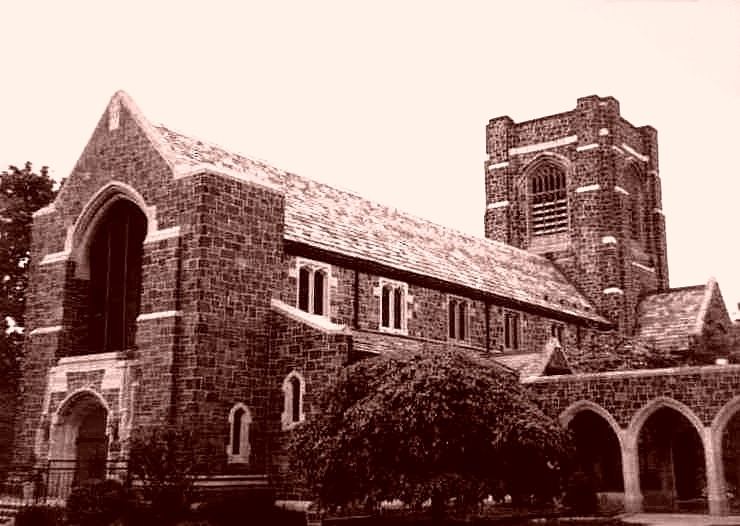Opened 1909 Architect Bertram Goodhue | Phone +1 860-523-5201 | |
 | ||
Address 679 Farmington Ave, West Hartford, CT 06119, USA Similar Congregation Beth Israel, Christ Church, West Hartford Public Lib, First Church of Christ - W, Cathedral of St Joseph Profiles | ||
St. John's Episcopal Church, West Hartford, Connecticut, is located at 679 Farmington Avenue near the Hartford, Connecticut, city line. The parish was founded in 1841 as St. John's Episcopal Church (Hartford, Connecticut). The church's present building, designed by famed architect Bertram Grosvenor Goodhue, opened in 1909. It is noted for its reredos designed by Mr. Goodhue and executed by prominent sculptor Lee Lawrie; its organ, Opus 2761 by Austin Organs, Inc., with 64 ranks and 3721 pipes; and its thirty-six stained glass windows by designers/manufacturers such as the Harry Eldredge Goodhue Company of Cambridge, Massachusetts, Wilbur H. Burnham Studios of Boston, Massachusetts, and London, England's James Powell and Sons.
Contents
Congregation history
St. John's Episcopal Church (Hartford, Connecticut) was founded in 1841, in downtown Hartford, Connecticut. Its first building was designed by Henry Austin (architect). An activist organization, St. John's was instrumental in the development of other prominent Hartford area churches including the Church of the Good Shepherd and Parish House (Hartford, Connecticut), St. John's Episcopal Church (East Hartford, Connecticut), and St. Monica's, the second Episcopal congregation in the state for African Americans. As the nineteenth century progressed, the western suburbs became increasingly popular as a place for city dwellers to live with the result that the number of St. John's worshipers was in decline. In 1907, financier J. P. Morgan purchased the church building and its property for the construction of a memorial gallery to be added to Hartford's Wadsworth Atheneum. St. John's Episcopal Church (Hartford, Connecticut) then moved to suburban West Hartford, Connecticut which was undergoing steady growth.
Present church building
The land for the current site, located adjacent to the main trolley line west from Hartford, was donated by longtime parishioners Dr. Thomas B. and John O. Enders. The firm of Cram, Goodhue and Ferguson was hired to design the new building with the assignment going to their New York Office headed by Mr. Goodhue. St. John's was the middle of three Episcopal churches designed by the New York Office in a relatively short period of time. The first was Christ Church in West Haven, Connecticut, and the last St. Mark's Episcopal Church (Mt. Kisco, New York) with each having a measure of similarity in the look of their exteriors and interiors. St. John's West Hartford held its first service in the new building on Easter Sunday, 1909.
As initially built, St. John's consisted of the church and a small office wing. Mr. Goodhue's plan for the site included a number of additional features which evolved during subsequent upgrades. In 1914-5 a small parish house with an auditorium was added to the structure and in 1922-3 a reredos and high altar designed by Mr. Goodhue and executed by sculptor Lee Lawrie were made part of a significant improvement to St. John's interior. A major facilities upgrade occurred in 1927 with the addition of two bays to the church to alleviate overcrowding, the construction of a large parish house with an adjacent cloister garden, and the installation of an outdoor pulpit built into a Peace Cross. 1955 brought the addition of a chapel, with its own pipe organ, to hold the burgeoning church school.
In October, 1992, a fire caused by spontaneous combustion did millions of dollars of damage to the church's interior and exterior including the complete destruction of the stained glass window over the reredos (which itself was lightly affected), the auditorium, the 1950 Austin Organ, and its antiphonal of 1978. Other smoke and fire damage occurred throughout the structure including the roof over the chancel and parts of the parish house. Church leaders moved forward to restore Mr. Goodhue's original designs as much as possible and to rejuvenate the infrastructure of the 83-year-old building. It reopened with a new altar window and auditorium, along with a large number of replaced or refurbished furnishings, for services in 1995. The new organ was dedicated in 1996.
Notable people
Dr. John Franklin Enders (1897-1985), a member of an important St. John's family, won the Nobel Prize in Physiology or Medicine in 1954. He was Baptized at St. John's Episcopal Church (Hartford, Connecticut), and later became a confirmed member of the Episcopal Church at the parish's then new location in West Hartford, Connecticut. Following his death in 1985, St. John's arranged a graveside service at Fairview Cemetery in West Hartford, his birthplace.
Among St. John's (West Hartford)'s many notable clergy have been two assistants who later became Bishops: Walter Henry Gray of the Episcopal Diocese of Connecticut and Kirk Stevan Smith of the Episcopal Diocese of Arizona.
Prominent musicians affiliated with St. John's (West Hartford) include organist and choirmaster Clarence E. Watters (at St. John's 1929–1932 and 1952–1976) who was one of Marcel Dupré's "first and most enduring disciples-exponents-friends", and with whom Watters studied in Paris. "One of [the 20th] century’s greatest organ virtuosos", Watters counted Charles-Marie Widor and other prominent organist/composers in his circle of friends and close associates.
Notable people related to St. John's Episcopal Church (Hartford, Connecticut) are found at that Wikipedia entry.
